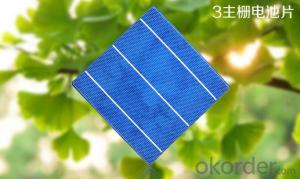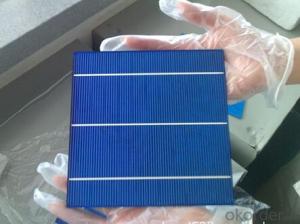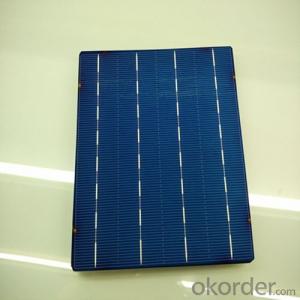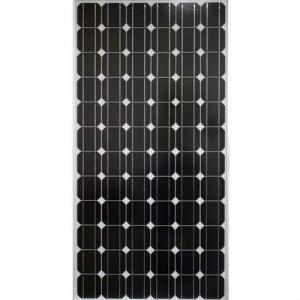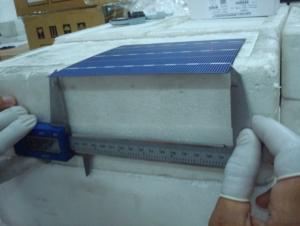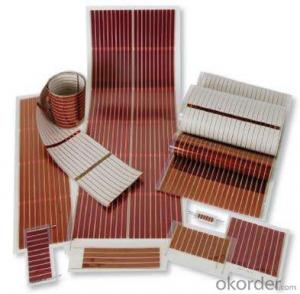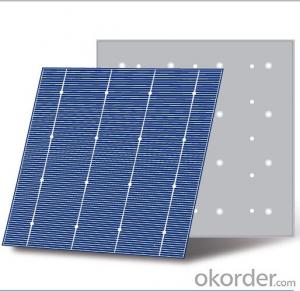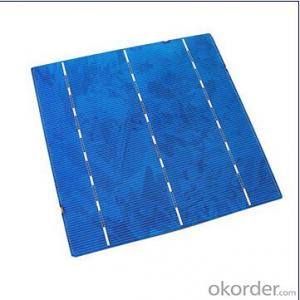PV Poly 3BB Triple Junction Solar Cells for Sale
- Loading Port:
- China Main Port
- Payment Terms:
- TT OR LC
- Min Order Qty:
- -
- Supply Capability:
- -
OKorder Service Pledge
OKorder Financial Service
You Might Also Like
PART1:Introduction:
We supply regular mono 125x125mm and poly 156x156mm solar cells.
Cells made in China mainland and Taiwan are both available.
Cell production capacity yearly reach 1GW.
Our cells pattern include continuous and uncontinuous busbar to meet different cells line.
THE CHARACTERISTIC OF 156P POLY-SILICON SOLAR CELLS
1.Format 156mm×156mm±0.5mm,Thickness 210μm±30μm.
2.High efficiency in photovoltaic conversion 16.3%~17.93%;
3.Low inverse current, high shunt resistance and high dependability.
4.Front(-): covered by dark blue silicon nitride anti-reflecting coating(silicon nitride) with bus bars(silver), 2/3/5 bud bars(silver).
5.Back(+): wide soldering pads(silver), back surface field(aluminum),high quality paste for the BSF and the electrode ensure higher tension and improve soldering easiness.

- Q: How do people price solar cells? Is it based on a specific way of calculating the cost of solar cells?
- According to our calculation the solar power cost around US$230 per square meter is it can generate 120W power supply per square meter.
- Q: Can solar cells be used for outdoor lighting?
- Yes, solar cells can definitely be used for outdoor lighting. Solar-powered outdoor lighting systems are a popular and eco-friendly alternative to traditional electric lighting. They harness sunlight during the day to charge their batteries, which then powers the lights during the night. This allows for sustainable and cost-effective illumination for various outdoor applications such as gardens, pathways, and street lighting.
- Q: Can solar cells be used in mountainous regions?
- Yes, solar cells can be used in mountainous regions. While mountainous regions may present challenges such as variable weather patterns and shadows from the surrounding landscape, solar cells can still effectively harness solar energy in these areas. With proper design and installation, solar panels can be angled and positioned to maximize sun exposure, allowing them to generate electricity even in mountainous terrain. Additionally, advancements in solar technology, such as more efficient and flexible panels, make it increasingly feasible to utilize solar energy in challenging geographical locations.
- Q: Can solar cells be integrated into building materials?
- Yes, solar cells can be integrated into building materials. This is known as building-integrated photovoltaics (BIPV) and involves embedding solar cells into various components of a building, such as roofs, windows, or walls, to generate electricity. BIPV offers a dual purpose by combining the functionality of traditional building materials with renewable energy generation.
- Q: Can solar cells be combined with energy storage systems?
- Yes, solar cells can be combined with energy storage systems. This integration allows for the excess energy generated by solar cells to be stored for later use, such as during periods of low sunlight or at night. Energy storage systems, such as batteries, enable a more reliable and efficient utilization of solar energy, making it a feasible and sustainable solution for meeting energy demands.
- Q: Are solar cells recyclable?
- Yes, solar cells are recyclable. The majority of their components, such as silicon, glass, and aluminum, can be recycled and reused to manufacture new solar panels. This helps reduce waste and minimize the environmental impact of solar cell disposal.
- Q: Can solar cells be used for powering electric vehicle charging stations with battery storage?
- Yes, solar cells can be used to power electric vehicle charging stations with battery storage. Solar panels can generate electricity from the sun's rays, which can be used to charge electric vehicles directly or stored in batteries for later use. This enables sustainable and renewable energy sources to power the charging stations, reducing reliance on fossil fuels and minimizing carbon emissions.
- Q: How do solar cells perform in high altitude locations?
- Solar cells tend to perform better in high altitude locations due to the thinner atmosphere. With less air to scatter and absorb sunlight, solar cells can capture more solar radiation, resulting in increased energy production. Additionally, the lower temperatures at higher altitudes can also enhance the efficiency of solar cells.
- Q: How do solar cells contribute to reducing carbon emissions?
- Solar cells contribute to reducing carbon emissions by converting sunlight directly into electricity without producing any greenhouse gases. This renewable energy source allows us to generate clean electricity, replacing the need for fossil fuel-based power generation that emits significant amounts of carbon dioxide and other pollutants. By adopting solar cells, we can reduce our dependence on fossil fuels and mitigate the harmful effects of carbon emissions on the environment and climate change.
- Q: What materials are used to make solar cells?
- Solar cells are typically made using materials such as silicon, cadmium telluride, and copper indium gallium selenide (CIGS).
Send your message to us
PV Poly 3BB Triple Junction Solar Cells for Sale
- Loading Port:
- China Main Port
- Payment Terms:
- TT OR LC
- Min Order Qty:
- -
- Supply Capability:
- -
OKorder Service Pledge
OKorder Financial Service
Similar products
Hot products
Hot Searches
Related keywords
